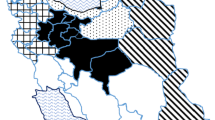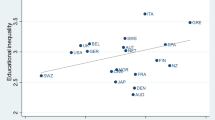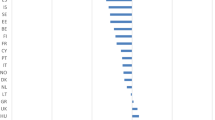Abstract
This study is based on the idea that education forms a quadratic relationship with the income inequality. To evaluate it for South Asian Association for Regional Cooperation (SAARC) countries, this study uses the panel data from 1990 to 2015. Long run panel data necessitated the use of panel co-integration approach, followed up with fully modified OLS model to generate long-run coefficients. The results depict that initially primary and secondary enrollment increases inequality while tertiary enrollment decreases it. However, after a certain threshold level of enrollment (76% for primary, 42% for secondary and 7% for tertiary), their effect reverses. Thus, it makes inverted U shape for primary and secondary enrollment and U shape for tertiary enrollment. Hence education shows diminishing marginal return effect. Only the countries of India, Sri Lanka, Maldives and Nepal in SAARC economies have high enough education enrollments to cause a negative effect on income inequality.

Similar content being viewed by others
Notes
The Tunnel Effect—http://www2.warwick.ac.uk/fac/soc/economics/news/2013/4/tunneleffect/.
Outlook Global Agenda 2015—Deepening Income Inequality. http://reports.weforum.org/outlook-global-agenda-2015/top-10-trends-of-2015/1-deepening-income-inequality/.
Dependent variable showed significant cross sectional correlation.
Mean of the dependent variable is significantly different across cross sections.
Which is because of high kurtosis of the variables.
Hence series have become time variant causing invalidity of simple OLS estimates (Gujarati 2009).
References
Aghion, P., Caroli, E., & Garcia-Penalosa, C. (1999). Inequality and economic growth: The perspective of the new growth theories. Journal of Economic Literature, 37(4), 1615–1660.
Aghion, P., & Howitt, P. (1992). A model of growth through creative destruction. Econometrica, 60, 323–351.
Ahluwalia, M. S. (1976). Income distribution and development: Some stylized facts. The American Economic Review, 66(2), 128–135.
Ahmad, S. (2013). Humanistic economics needed to sustain society. Indian Journal of Economics and Development, 1(4), 98–99.
Alderson, A. S., & Nielsen, F. (2002). Globalization and the great U-turn: Income inequality trends in 16 OECD countries I. American Journal of Sociology, 107(5), 1244–1299.
Anand, S., & Kanbur, S. R. (1993). The Kuznets process and the inequality—Development relationship. Journal of Development Economics, 40(1), 25–52.
Barro, R. J. (1990). Government spending in a simple model of endogeneous growth. Journal of Political Economy, 98(5, Part 2), S103–S125.
Barro, R. J. (1991). Economic growth in a cross section of countries. The Quarterly Journal of Economics, 106(2), 407–443.
Barro, R. J. (1996). Determinants of economic growth: A cross-country empirical study (No. w5698). National Bureau of Economic Research. Retrieved from http://www.nber.org/papers/w5698.
Barro, R. J. (1999). Inequality, growth, and investment (No. w7038). National bureau of economic research. Retrieved from http://www.nber.org/papers/w7038.pdf.
Barro, R. J. (2000). Inequality and growth in a panel of countries. Journal of Economic Growth, 5(1), 5–32.
Benabou, R. (1996). Inequality and growth. NBER Macroeconomics Annual, 11, 11–74.
Benoit, K. (2011). Linear regression models with logarithmic transformations. London School of Economics, 22(1), 23–36.
Bils, M., & Klenow, P. J. (2000). Does schooling cause growth? American Economic Review, 90(5), 1160–1183.
Brasington, D. M. (2002). Differences in the production of education across regions and urban and rural areas. Regional Studies, 36(2), 137–145.
Byanyima, W. (2017). 8 men have the same wealth as 3.6 billion of the world’s poorest people. We must rebalance the unjust economy. World Economic Forum Annual Meeting 2017. Retrieved from https://www.weforum.org/agenda/2017/01/eight-men-have-the-same-wealth-as-3-6-billion-of-the-worlds-poorest-people-we-must-rebalance-this-unjust-economy/.
Checchi, D. (2001). Education, inequality and income inequality. LSE STICERD Research Paper 52. Retrieved from https://papers.ssrn.com/sol3/papers.cfm?abstract_id=1094825.
Chu, M. K. Y., Davoodi, M. H. R., & Gupta, M. S. (2000). Income distribution and tax and government social spending policies in develo** countries (No. 0-62). Washington: International Monetary Fund.
Collier, P., & Dollar, D. (2001). Can the world cut poverty in half? How policy reform and effective aid can meet international development goals. World Development, 29(11), 1787–1802.
Crenshaw, E. (1992). Cross-national determinants of income inequality: A replication and extension using ecological-evolutionary theory. Social Forces, 71(2), 339–363.
Crenshaw, E., & Ameen, A. (1994). The distribution of income across national-populations: Testing multiple paradigms. Social Science Research, 23(1), 1–22.
Deininger, K., & Squire, L. (1998). New ways of looking at old issues: Inequality and growth. Journal of Development Economics, 57(2), 259–287.
Eberhardt, M. (2011). Panel time-series modeling: New tools for analyzing xt data. UK Stata User Group meeting, Cass Business School, London. Retrieved from http://www.timberlake.co.uk/media/pdf/proceedings/UK11_eberhardt.pdf.
Fields, G. S. (1980). Education and income distribution in develo** countries: A review of the literature. In T. King (Ed.), Education and income: A background study for world development (pp. 231–315). Washington, DC: The World Bank (electronic version).
Fisher, R. A. (1925). Statistical methods for research workers. Guildford: Genesis Publishing Pvt Ltd.
Gregorio, J. D., & Lee, J. W. (2002). Education and income inequality: New evidence from cross-country data. Review of Income and Wealth, 48(3), 395–416.
Gujarati, D. N. (2009). Basic econometrics. Ahmadabad: Tata McGraw-Hill Education.
Gupta, S., Davoodi, H., & Alonso-Terme, R. (2002). Does corruption affect income inequality and poverty? Economics of Governance, 3(1), 23–45.
Hanif, N., & Arshed, N. (2016). Relationship between school education and economic growth: SAARC countries. International Journal of Economics and Financial Issues, 6(1), 294–300.
Hanushek, E. A., & Kimko, D. D. (2000). Schooling, labor-force quality, and the growth of nations. American Economic Review, 90(5), 1184–1208.
Hills, J. (2010). An anatomy of economic inequality in the UK-report of the National Equality Panel. Retrieved from https://papers.ssrn.com/sol3/papers.cfm?abstract_id=1546894.
Hirschman, A. O., & Rothschild, M. (1973). The changing tolerance for income inequality in the course of economic development* with a mathematical appendix. The Quarterly Journal of Economics, 87(4), 544–566.
Im, K. S., Pesaran, M. H., & Shin, Y. (1997). Testing for unit roots in heterogeneous panels (No. 9526). Cambridge: University of Cambridge.
Kanwal, A., & Munir, K. (2015). The impact of educational and gender inequality on income inequality in South Asia. Retrieved from https://mpra.ub.uni-muenchen.de/66661/.
Kao, C. (1999). Spurious regression and residual-based tests for cointegration in panel data. Journal of Econometrics, 90(1), 1–44.
Karim, M. R. (2015). Public education spending and income inequality in Bangladesh. International Journal of Social Science and Humanity, 5(1), 75–79.
Kuznets, S. (1956). Quantitative aspects of the economic growth of nations: Level and variability of rates of growth. Economic Development and Cultural Change, 5(1), 5–94.
Kuznets, S. (1995). Economic growth and income inequality. American Economic, 49, 1–28.
Levin, A., Lin, C. F., & Chu, C. S. J. (2002). Unit root tests in panel data: Asymptotic and finite-sample properties. Journal of Econometrics, 108(1), 1–24.
Lin, C. H. A. (2007). Education expansion, educational inequality, and income inequality: Evidence from Taiwan, 1976–2003. Social Indicators Research, 80(3), 601–615.
Maass, C. D. (1996). South Asia: Drawn between cooperation and conflict. South Asian Survey, 3(1–2), 259–276.
Maddala, G. S., & Wu, S. (1999). A comparative study of unit root tests with panel data and a new simple test. Oxford Bulletin of Economics and Statistics, 61(S1), 631–652.
Mankiw, N. G., Romer, D., & Weil, D. N. (1992). A contribution to the empirics of economic growth. The Quarterly Journal of Economics, 107(2), 407–437.
Marin, A., & Psacharopoulos, G. (1976). Schooling and income distribution. The Review of Economics and Statistics, 58(3), 332–338.
Moene, K. O., & Wallerstein, M. (2001). Inequality, social insurance, and redistribution. American Political Science Review, 95(4), 859–874.
Nielsen, F. (1994). Income inequality and industrial development: Dualism revisited. American Sociological Review, 59(5), 654–677.
Nielsen, F., & Alderson, A. S. (1997). The Kuznets curve and the great U-turn: Income inequality in US counties, 1970 to 1990. American Sociological Review, 62(1), 12–33.
Ostry, M. J. D., Berg, M. A., & Tsangarides, M. C. G. (2014). Redistribution, inequality, and growth. Washington: International Monetary Fund.
Oxfam. (2017). An economy for the 99%. Oxfam Briefing Paper. Retrieved from https://www.oxfam.org/sites/www.oxfam.org/files/file_attachments/bp-economy-for-99-percent-160117-en.pdf.
Park, K. (1996). Educational expansion and educational inequality on income distribution. Economics of Education Review, 49, 411–437.
Pedroni, P. (2001). Fully modified OLS for heterogeneous cointegrated panels. In B. H. Baltagi, T. B. Fomby, & R. C. Hill (Eds.), Nonstationary panels, panel cointegration, and dynamic panels (Advances in Econometrics, Vol. 15, pp. 93–130). Bingley: Emerald Group Publishing Limited.
Pedroni, P. (2008). Nonstationary panel data. Notes for IMF Course (not publically available).
Phillips, P., & Hansen, B. (1990). Statistical inference in instrumental variables regression with l (1) processes. Review of Economic Studies, 57, 99–125.
Ravallion, M. (2001). Growth, inequality and poverty: Looking beyond averages. World Development, 29(11), 1803–1815.
Robinson, S. (1976). A note on the U hypothesis relating income inequality and economic development. The American Economic Review, 66(3), 437–440.
Rodríguez-Pose, A., & Tselios, V. (2010). Inequalities in income and education and regional economic growth in Western Europe. The Annals of Regional Science, 44(2), 349–375.
Schultz, T. W. (1961). Investment in human capital. The American Economic Review, 51(1), 1–17.
Simpson, M. (1990). Political rights and income inequality: A cross-national test. American Sociological Review, 55(5), 682–693.
Solow, R. M. (1956). A contribution to the theory of economic growth. The Quarterly Journal of Economics, 70(1), 65–94.
Solt, F. (2009). Standardizing the world income inequality database. Social Science Quarterly, 90(2), 231–242.
Staff, O. E. C. D. (2009). Growing unequal? Income distribution and poverty in OECD countries. Paris: Organization for Economic.
Sylwester, K. (2002). Can education expenditures reduce income inequality? Economics of Education Review, 21(1), 43–52.
WDI. (2016). World Development Indicators. Retrieved from The World Bank. http://data.worldbank.org/indicator/GB.XPD.RSDV.GD.ZS.
Weede, E. (1993). The impact of democracy or repressiveness on the quality of life, income distribution and economic growth rates. International Sociology, 8(2), 177–195.
Author information
Authors and Affiliations
Corresponding author
Rights and permissions
About this article
Cite this article
Arshed, N., Anwar, A., Kousar, N. et al. Education Enrollment Level and Income Inequality: A Case of SAARC Economies. Soc Indic Res 140, 1211–1224 (2018). https://doi.org/10.1007/s11205-017-1824-9
Accepted:
Published:
Issue Date:
DOI: https://doi.org/10.1007/s11205-017-1824-9




